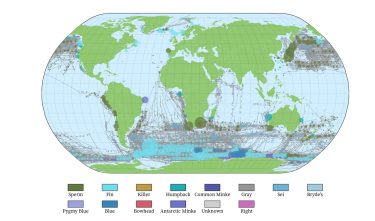
Even though they’re the largest animals on earth, whales remain difficult to track. So experts often turn to historical whaling data to inform current research. A dataset maintained by the International Whaling Commission (IWC) contains detailed information on commercial whale catches — more than 2.1 million records, predominantly from 1880 until the IWC banned whaling in 1986. Yet for researchers, distilling that data can prove its own challenge.
A team at the University of Washington has created an online interactive map called WhaleVis, which lets whale researchers visualize the IWC’s data on global whale catches and whaling routes. From this, researchers can estimate the animals’ spatial distribution and the effort whalers put into hunts.
By comparing historical data and its trends with current information, scientists can better understand how populations of whales have changed over time, where they’ve been, and how to better protect those still living.
The UW team presented its research Oct. 25 at the IEEE VIS conference in Melbourne (Narrm), Australia. The tool is online, but users must have permission from the IWC to access it.
“It was important to make this data accessible so it can easily be used to generate actionable insights,” said lead author Ameya Patil, a UW doctoral student in the Allen School. “Tools like this make information more tangible and comprehensible.”
WhaleVis came about through the UW’s Computing for the Environment, an initiative bringing together computer and climate scientists to collaborate. Trevor Branch, a co-author on the paper and UW professor in the School of Aquatic and Fishery Sciences, had been working with the IWC data set and wanted help visualizing it, especially in such a way that would estimate how much effort had gone into each whale catch.
Zoe Rand, a doctoral student in quantitative ecology and resource management, also is a co-author on this paper.
Read more at UW News »
